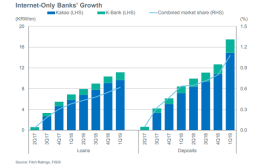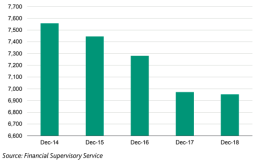Korea
COVID-19 accelerates digital payments adoption in South Korea
The country’s credit card issuers are seeing a rise in credit card use for online purchases.
COVID-19 accelerates digital payments adoption in South Korea
The country’s credit card issuers are seeing a rise in credit card use for online purchases.
Korean banks face irreversible headwinds as disruptions persist
Four regional banks are particularly at risk of asset-quality deterioration.
South Korea and China are Asia's cashless leaders
More than half of Korea’s 1,600 bank branches no longer accept cash deposits or withdrawals.
South Korea NPL ratios still strong despite multi-year lows
Asset quality remains stable.
South Korean banks stay ahead despite digital surge: report
Fintech companies will stay focused on money transfers and other simple transaction services.
Why Korean banks will remain steady despite subdued Q3 profits
They stand to benefit from expansions and from the low-rate policy environment.
How kakaobank successfully cracked the profitability code two years after rocket launch
In the first half of the year ended June 31, kakaobank hauled net income of KRW10b ($8.58m), booking net profit for the first time following a protracted loss-making period.
Cards to reign supreme in South Korea as cash loses appeal
By 2020, cards will emerge as the dominant payment instrument.
Mobile banking transactions in Korea hit $5b in H1 2019
Internet-only banks drove robust adoption.
Internet banking transactions in Korea hit record high in 2018
The number of transactions broke the 100-million mark for the first time.
Chart of the Week: Korea's internet-only banks still sparring for market share
The two players only account for 0.6% of the loan market in Q1.
Finda helps on-the-go Koreans in securing loans
It offers evaluation of personal loans without having to submit hard copy of documents.
Korean banks forge consortium to develop blockchain-based mobile identification
It will allow individuals to store key personal information needed for online transactions.
Korea resumes applications for third internet-only bank
Rejected applicants Toss Bank and Kiwoom Securities are welcome to re-apply.
Chart of the Week: Korean virtual banks still struggling to crack the profitability code
ROAA is still relatively low at -0.9% in December 2018.
Chart of the Week: How many branches do Korean banks have left?
The number fell from as high as over 7,500 in 2014.
Korea's virtual banks still struggle to find footing
Lenders grapple with low profitability and limited capital two years since they kicked off. After two years since their debut, Korean virtual lenders Kakao Bank and K Bank have managed to capture just 0.6% of the KRW-denominated loans market as of end 2018, according to a report by Moody’s with data from the Financial Supervisory Service (FSS). The lenders have been the most active in the unsecured personal loan market with plans to extend to retail loan segments like mortgages. “Korea’s two virtual banks have brought modest competition in some retail loan segments but no broad disruption in the two years they have been operating,” the report said. To jockey for market share, the ratings agency noted that K bank has a loan portfolio geared toward non-prime borrowers or individuals with credit rating less than four out of 10, pushing its delinquency rate above the regional banks. Meanwhile, Kakao Bank, with a higher portion of prime borrowers, has shown better asset quality compared to its commercial bank peers. Kakao Bank has focused its lending business on prime borrowers, and its proportion of loans with lending rates of less than 4% was at around 82% of total newly extended loans in May 2019. “Virtual banks have not yet shown competitive advantages in using proprietary data sources for underwriting. We expect asset quality of the virtual banks will reflect on the risk undertaken in terms of the proportion of high risk borrowers,” Moody’s said.


















 Advertise
Advertise




















